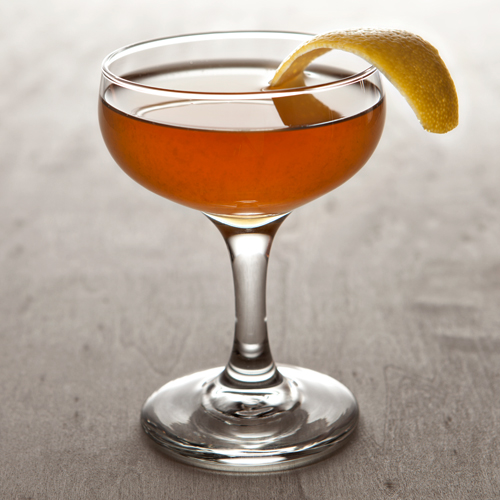I was reminded today of the cocktail culture’s influence on whiskey sales in the United States. I know that most well-seasoned whiskey drinkers will insist on either only a few ice cubes or that their whiskey be served neat. Sometimes a whiskey drinker will refuse to order a cocktail because they aren’t sure what’s being served. I thought I’d take a moment to point out what you’re missing out on and give some explanations of what these crazy elixirs are…
We all know the old fashioned that’s served in a rocks glass-that ubiquitous short glass that usually has a weighted bottom. Many cocktails will be served in a highball glass, which is a tall thin glass that most of us would get water served in when we order our whiskey neat. (A highball is just any simple, two ingredient mixed drink on ice- a gin and tonic or a rum and coke are both highballs) The standard cocktail glass is the martini glass- that cone shaped glass with a stem. I know plenty of people that prefer whatever cocktail they are ordering to be served in a rocks glass, instead, because they don’t like how a martini glass looks or feels in their hand. Bartenders will accommodate you if you specify your glassware choice. (Just say, “Please serve my drink in a rocks glass”) The most popular glass for cocktails nowadays is the coupe glass. It was popular in the early 20th century for champagne before the champagne flute took over. Picture a shallow glass bowl on a stem. The image in this post is a coupe glass.
Some words in a cocktail description can be confusing as well. If something is muddled, that just means that a tool with a blunt end was used to pulverize a fruit or herbal ingredient in your drink. Muddling mint, for instance, will break open the flavors in the leaf and will infuse them more fully into your cocktail. (You hope that the bartender strains out any solids from the muddling process so you don’t end up with herbs or seeds in your teeth!) Sometimes you’ll see the bartender slap an herb before garnishing your drink with it. That just helps to open up the aromatics in the plant. A glass may be rimmed with citrus. That means the bartender dragged the peel used for garnish along the rim of the glass so when you take that first sip the oils get onto your lip. It’s a great technique for adding a touch of flavor. There’s always the very cool flaming zest where a bartender squeezes a citrus rind and lights the oily zest on fire! It makes for a good show, but it also adds a delicious smokey element to the drink.
A big one that people ask is why should a cocktail be shaken or stirred? If your cocktail has fruit, syrups, egg or dairy in it, your drink will probably be shaken. It mixes the ingredients well, the ice will chip and break, and the cocktail will have more water added to it balancing the drink. (I’m sure you’ve seen the shaker being jostled like a maraca before.) A stirred cocktail will not have ingredients other than spirits or a light mixer. Stirring the drink adds less water to the cocktail (not as much heat transfer as shaking), it helps maintain the integrity of the ingredients (adding water to whiskey changes the flavor significantly), and lowers the proof. Shaking also adds lots of bubbles and clouds an otherwise beautiful drink.
There are too many terms that bartenders use to describe drinks so I included a glossary for reference. I encourage people to ask the bartender what he/she would recommend for you. If you like a unadulterated whiskey, I’m sure they could recommend a cocktail that even your discerning palate would find delicious!


